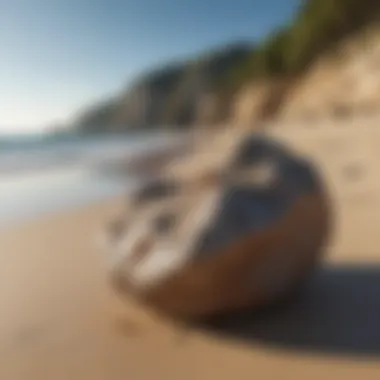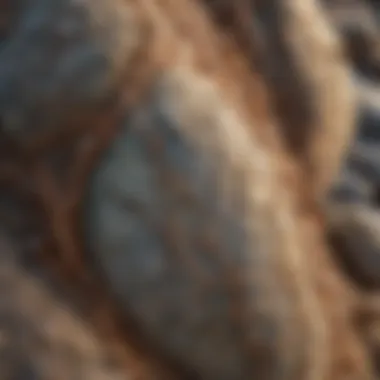Unveiling the Wonders of Beach Rocks: A Comprehensive Guide to Identification


Rock and Fossil Identification
When embarking on the captivating journey of beach rock identification, it is vital to first grasp the fundamental aspects of rock and fossil identification. Understanding the various types of rocks and fossils that can be found along the shorelines is imperative. Whether it be sedimentary, igneous, or metamorphic rocks, each type carries distinct features that aid in identification. Similarly, fossils offer a glimpse into the past, allowing collectors to piece together the geological history embedded within these remnants. Recognizing key characteristics such as color, texture, and fossil imprints is essential in discerning one specimen from another. Utilizing specialized tools like magnifying lenses and mineral hardness kits can further facilitate the identification process, enabling enthusiasts to unlock the secrets held within each rock or fossil.
Collecting Tips and Techniques
Exploration and collection are integral facets of the beach rock identification experience. For enthusiasts seeking to expand their collections, adopting best practices for collecting is paramount. This includes respecting environmental regulations, obtaining permissions where necessary, and employing ethical collection methods to ensure the preservation of these natural marvels. Locating prime collecting sites along coastlines or near geological formations increases the likelihood of discovering unique specimens. When extracting rocks or fossils, practicing caution and using appropriate tools will help safeguard both the collector and the specimen. By adhering to safety protocols and handling techniques, collectors can acquire treasures from the shorelines with minimal impact on the environment.
Preservation and Display
Once in possession of these geological wonders, it becomes essential to understand the art of preservation and display. Preserving rocks and fossils involves employing techniques such as cleaning, drying, and sealing to prevent deterioration over time. Proper storage methods, such as utilizing acid-free containers or climate-controlled environments, play a significant role in maintaining the integrity of these specimens. Furthermore, showcasing these natural artifacts can be a creative endeavor. Experimenting with various display ideas, whether utilizing shadow boxes, stands, or specialized lighting, can enhance the aesthetic appeal of the collection while also ensuring longevity.
Geological Insights
Delving deeper into beach rock identification unveils a wealth of geological insights that shed light on the Earth's history. By understanding the formations and processes that give rise to these rocks and fossils, enthusiasts gain a deeper appreciation for the forces at play. Exploring the historical significance of these geological treasures provides a glimpse into ancient ecosystems and evolutionary timelines. Moreover, learning about notable discoveries in the field of beach rock identification underscores the ongoing discoveries and contributions to the scientific community, showcasing the endless fascination that these coastal wonders continue to evoke.
Introduction to Beach Rocks
Beach rocks encompass a captivating subject within the realm of geology, offering a glimpse into the intricate processes that shape our coastal landscapes. This section serves as a foundational pillar for our exploration, shedding light on the essence of beach rocks and their significance in the wider geological and ecological spheres. By understanding the origins and characteristics of beach rocks, enthusiasts and collectors are equipped to delve deeper into the nuances of rock and fossil identification, enriching their knowledge and appreciation for the natural world.
What are Beach Rocks?
Composition and Origins
Exploring the composition and origins of beach rocks unveils a world of diverse elements interwoven through geological time. The intricate blend of minerals and sediments composing beach rocks reflects millennia of geological processes, instilling each rock with a unique story waiting to be deciphered. By examining the composition and origins of beach rocks, enthusiasts are primed to unravel the complexities of these formations and grasp the geological tapestry underpinning their existence.
Characteristics and Properties
Diving into the characteristics and properties of beach rocks unveils a trove of essential insights crucial for identification and interpretation. From coloration patterns to texture analysis, each facet offers a window into the history and formation of these coastal treasures. Understanding the nuances of characteristics and properties empowers collectors to discern key features, fostering a deep appreciation for the intricate details woven into each beach rock.
Significance of Beach Rocks
Geological Importance
Within the grand scheme of geological studies, beach rocks occupy a vital niche, providing valuable clues about past environments and tectonic events. Their geological importance lies in serving as archives of shifting landscapes and climatic conditions, offering researchers a glimpse into bygone eras through meticulous examination. By decoding the geological significance of beach rocks, enthusiasts unlock a portal to the Earth's history, enriching their understanding of the planet's ever-evolving surface.
Ecological Role


Beyond their geological implications, beach rocks play a crucial ecological role in coastal ecosystems, serving as habitats for diverse marine life forms and influencing shoreline dynamics. Their presence influences erosion patterns and sedimentation processes, contributing to the delicate balance of coastal environments. Delving into the ecological role of beach rocks illuminates the intricate dance between geology and ecology, showcasing the interconnectedness of natural systems in shaping our coastal landscapes.
Interest in Beach Rock Collection
Collector Communities
The realm of beach rock collection harbors vibrant communities of enthusiasts drawn together by a shared passion for geological wonders. Collector communities form hubs of knowledge exchange and collaboration, fostering a deep appreciation for the beauty and complexity of beach rocks. Engaging with these communities offers collectors a gateway to expand their understanding and forge lasting connections with like-minded individuals passionate about the Earth's geological tapestry.
Market Value
Apart from their intrinsic beauty and scientific value, beach rocks hold a significant market value in the realm of collectors and connoisseurs. Rare specimens and unique formations can command substantial prices in specialized markets, reflecting the allure and demand for these geological treasures. Exploring the market value of beach rocks unveils a niche world where rarity and aesthetic appeal converge, offering collectors a glimpse into the dynamic landscape of geological commerce.
Identification Techniques
In the realm of beach rock identification, understanding various identification techniques is crucial for enthusiasts and collectors. These techniques play a vital role in discerning the composition and origins of beach rocks, as well as their characteristics and properties. By delving into visual examination, mineralogical analysis, and comparative studies, collectors can enhance their knowledge and appreciation of beach rocks extensively.
Visual Examination
Coloration Patterns
Coloration patterns in beach rocks offer valuable insights into their composition and formation process. The varying hues and shades present in these rocks can indicate the different minerals and elements embedded within them. By closely examining these coloration patterns, collectors can decipher valuable information about the geological history and environmental factors affecting the rock's appearance. The unique feature of coloration patterns lies in their ability to visually narrate the story of a beach rock, making them a popular choice for collectors seeking to unearth the secrets held within these formations.
Texture Analysis
Texture analysis involves a tactile exploration of beach rocks to determine their surface characteristics and structure. The texture of a rock can provide clues about its formation process, weathering effects, and durability. By carefully studying the textures present in beach rocks, enthusiasts can unveil details about the rock's history and evolutionary journey. The advantage of texture analysis lies in its ability to offer a hands-on approach to understanding beach rocks, allowing collectors to appreciate the intricate details and complexities of these geological treasures.
Mineralogical Analysis
XRF Testing
XRF testing, or X-ray fluorescence testing, is a powerful technique for analyzing the elemental composition of beach rocks. This non-destructive method allows collectors to identify the specific elements present in a rock sample by measuring the fluorescence emitted when the sample is irradiated with X-rays. The key characteristic of XRF testing is its precision and accuracy in elemental analysis, making it a valuable choice for in-depth mineralogical investigations. Collectors can benefit from XRF testing by gaining comprehensive insights into the chemical makeup of beach rocks, aiding in their classification and understanding of these formations.
Microscopic Study
Microscopic study involves examining thin sections of beach rocks under a microscope to observe their mineralogical structures and textures at a microscopic level. This technique enables collectors to identify rare minerals, analyze crystal formations, and investigate mineral associations within the rock matrix. The unique feature of microscopic study lies in its ability to unveil intricate details that are invisible to the naked eye, providing a deeper understanding of the geological processes that shaped the beach rocks. By conducting microscopic studies, enthusiasts can enhance their expertise in identifying and interpreting the mineralogical complexities of these formations.
Comparative Studies


Reference Collections
Reference collections serve as invaluable resources for collectors to compare and contrast different beach rock samples with known specimens. By building a repository of reference samples, enthusiasts can enhance their ability to identify unique rocks, understand geological variations, and expand their knowledge base. The key characteristic of reference collections is their role in aiding collectors during rock identification processes, enabling them to make informed assessments based on comparative analyses. Collectors can leverage reference collections to strengthen their expertise and refine their classification skills in the intricate world of beach rock identification.
Expert Consultation
Expert consultation offers collectors the opportunity to seek guidance and insights from experienced professionals in the field of geology and mineralogy. By consulting with experts, collectors can receive expert opinions, interpretations, and recommendations regarding challenging rock specimens or complex geological formations. The advantage of expert consultation lies in the wealth of knowledge and expertise that seasoned professionals bring to the table, offering collectors valuable perspectives and explanations that can enhance their understanding and appreciation of beach rocks. Through expert consultations, enthusiasts can elevate their exploration of beach rock identification and enrich their passion for geological treasures.
Key Characteristics
In the realm of beach rock identification, understanding key characteristics plays a pivotal role. These features provide valuable insights into the geological history, formation processes, and ecological significance of beach rocks. Weathering patterns and fossil inclusions are key elements that enthusiasts and collectors look for when examining beach rocks. By analyzing erosion effects and surface features, one can unravel the effects of time and environmental exposure on these formations.
Weathering Patterns
Erosion Effects
When delving into beach rock identification, exploring erosion effects becomes paramount. Erosion effects showcase the dynamic interaction between rocks and their surrounding elements. By scrutinizing the erosion patterns, collectors can determine the rock's age, exposure history, and the environmental conditions it endured. The distinct erosion markings offer valuable clues about the rock's journey, highlighting its resilience and durability in facing natural forces.
Surface Features
Another crucial aspect of weathering patterns is surface features. These features provide a window into the rock's composition and history. By examining the surface texture, collectors can discern the level of exposure, the type of weathering agents the rock encountered, and even potential fossil remnants within its layers. Surface features serve as a visual narrative of the rock's transformation over time, making them essential indicators in identifying and studying beach rocks.
Fossil Inclusions
Imprint Identification
The presence of fossils within beach rocks is a captivating aspect of identification. Imprint identification involves recognizing and interpreting fossil imprints preserved within the rock. These imprints offer a direct connection to the past, providing insights into the ancient ecosystems and species that once thrived in the area. By studying imprint characteristics, such as shape, clarity, and distribution, collectors can expand their knowledge of paleontological diversity and the geological history encapsulated in these rocks.
Paleontological Significance
Furthermore, the paleontological significance of fossil inclusions cannot be overstated in beach rock identification. Unearthing fossils within beach rocks allows researchers and collectors to reconstruct past environments, track evolutionary changes, and analyze biological adaptations. The paleontological significance of these fossils extends beyond simple identification; it contributes vital data to the broader understanding of Earth's history. By exploring the unique features and preservation conditions of these inclusions, enthusiasts can appreciate the intricate tapestry of life preserved within beach rocks.
Preservation Methods
Preservation methods play a critical role in the realm of beach rock identification, safeguarding these geological treasures for future study and enjoyment. Ensuring the longevity and integrity of beach rocks is essential in maintaining their scientific and aesthetic value. Implementing proper preservation techniques not only protects the specimens from degradation but also allows for continued research and appreciation. By understanding the significance of preservation methods, enthusiasts and collectors can contribute to the preservation of valuable geological insights.
Storage Techniques


When it comes to preserving beach rocks, storage techniques are paramount in maintaining their quality and longevity. Proper storage helps prevent deterioration and minimizes external factors that can negatively impact the rocks. Two fundamental aspects of storage techniques include humidity control and light exposure.
Humidity Control
Humidity control is a critical factor in preserving beach rocks, as excessive moisture can lead to the growth of mold and deterioration of the specimens. By regulating the humidity levels in storage environments, collectors can create an optimal setting that prevents damage and prolongs the lifespan of the rocks. Maintaining a stable humidity level is essential for preserving the texture, color, and composition of beach rocks.
Light Exposure
Light exposure is another essential consideration in storage techniques for beach rocks. Exposure to direct sunlight or harsh artificial lighting can lead to fading and discoloration of the specimens. Protecting beach rocks from excessive light exposure is crucial in preventing damage and maintaining their visual appeal. Shielding the rocks from UV radiation helps preserve their natural features and prevents deterioration over time.
Cleaning Procedures
In addition to storage techniques, proper cleaning procedures are vital for maintaining the condition of beach rocks. Cleaning not only enhances the aesthetic appearance of the specimens but also removes impurities and debris that can affect their authenticity and scientific value. Two key aspects of cleaning procedures include avoiding damage and employing chemical approaches.
Avoiding Damage
Avoiding damage during the cleaning process is crucial to preserving the integrity of beach rocks. Gentle handling and using soft-bristled brushes help prevent scratches and abrasions on the surface of the specimens. By taking precautionary measures and using specialized tools, collectors can effectively clean beach rocks without compromising their structural integrity.
Chemical Approaches
In some cases, chemical approaches may be necessary to remove stubborn stains or deposits from beach rocks. However, caution must be exercised when using chemicals to clean the specimens, as harsh substances can react with the rock material and cause irreversible damage. Before applying any chemical solutions, it is essential to conduct thorough research and testing to ensure their compatibility with the rock composition. When employed correctly, chemical approaches can effectively restore the natural beauty of beach rocks while preserving their geological characteristics.
Advanced Topics in Beach Rock Study
In this article, we delve deep into the field of advanced topics in beach rock study, aiming to provide an in-depth exploration of crucial aspects that enhance our understanding of beach rocks. Advanced topics play a vital role in expanding our knowledge base and exploring the intricate details within beach rock identification. By focusing on advanced topics, enthusiasts and collectors can gain valuable insights into the geological history and rare formations found in beach rocks. Delving into these advanced areas allows for a more comprehensive analysis of beach rocks, providing a deeper appreciation for these natural wonders.
Geological Age Determination
Radiometric Dating
Radiometric dating stands out as a significant aspect of determining the geological age of beach rocks in this article. Its key characteristic lies in its ability to accurately quantify the decay of radioactive isotopes within rock samples, thereby providing a precise estimation of rock ages. The benefit of radiometric dating within this context is its high level of accuracy, making it a popular choice for studying beach rock formations. Despite its advantages, radiometric dating may have limitations in certain rock types or conditions, requiring careful consideration of sample selection and interpretational factors in this article.
Stratigraphic Analysis
Stratigraphic analysis serves as another fundamental component contributing to the geological age determination of beach rocks explored in this article. The primary characteristic of stratigraphic analysis is its focus on studying the layering and sequences of rocks to establish a geological timeline. This method is beneficial for understanding the relative age of beach rocks and their chronological placement within the geological record. While stratigraphic analysis offers valuable insights, its effectiveness may vary depending on the available rock exposures and the complexity of sedimentary profiles under examination in this article.
Rare Specimen Identification
In the realm of rare specimen identification, we uncover unique aspects that hold significance in the study of beach rocks. Examining uncommon formations sheds light on the exceptional diversity present in beach rock landscapes, showcasing rare geological phenomena that offer valuable insights into Earth's history. Highlighting these key characteristics contributes to a more nuanced understanding of beach rock diversity, enriching the exploration for enthusiasts and collectors. While rare specimen identification provides valuable information, complexities in characterization and limited occurrence present challenges that must be navigated with care in this article.
Experimental Techniques
Exploring experimental techniques opens up new avenues for rare specimen identification within the beach rock domain. The key characteristic of experimental techniques lies in the innovative approaches applied to analyze unique rock samples and formations that defy conventional classification. By integrating experimental methods, researchers can uncover hidden details and properties of rare beach rocks, expanding our knowledge base in this article. Although experimental techniques offer insights, challenges such as resource utilization and interpretational uncertainties may influence the outcomes of these analyses in the beach rock study.







